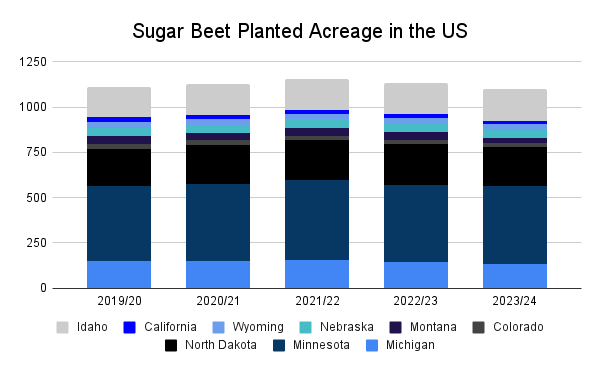Sugar Beet Acreage for 2023/24 in the US Set to Decrease Due to Diminishing Profitability and Weather Concerns

According to the National Agricultural Statistics Service (NASS), the initial forecast for the 2023/24 sugar beet planted acreage in the US is expected to fall to 1.111 million acres, down 2.9% from 1.143 million acres in 2022/23. Increases in Oregon, Nebraska, Idaho, and Minnesota will not be enough to offset the reduction in North Dakota, Montana, Michigan, California, Colorado, and Wyoming.

Source: Tridge, NASS
The most affected states are North Dakota and Montana, where the planted area is expected to fall by 19K acres and 12K acres down to 214K acres and 24K acres, respectively. In April, the closure of Sidney Sugars, a processing plant located in Sidney, Montana, led to a 33% decline in planted area, as the company was one of the largest processors in the state, sourcing sugar beets from five counties in eastern Montana and two counties in North Dakota. The closure of the plant resulted from the rapid decline in planted area in Montana over the past four years, which has reduced the profitability of the crop. In 2019/20, Montana’s planted area was 47K acres, dropping by 48.9% to 24K acres this year. During this time, the state moved from having the fifth-largest sugar beet planted area down to the seventh-largest in the country.
In Michigan, the 12K decline in planting intentions to 133K acres can be attributed to the attractive prices of alternative crops of rotation, such as corn and soybean. According to Tridge’s wholesale price data, in Michigan, corn traded at USD 2.03/kg on the 27th of February, while export prices of beet sugar, which are usually higher than wholesale prices, were as low as USD 1.17/kg, based on USDA data. As a result, corn and soybean planted area is expected to increase in 2023, with corn expected to rise by 4% YoY to 92 million acres, while soybean planted area is set to rise slightly by about 100K acres to 87.5 million acres.
In California, drought concerns in the Imperial Valley, the largest sugarbeet-producing county in the state, have shrunk the planted area by 6K acres, down to 18K acres. Declines of 1,000 and 2,000 acres were also projected in Colorado and Wyoming, respectively.
Planting usually occurs between April and May, allowing the sugar beets ample time to deposit sugar. However, planting could be delayed this year owing to recent weather anomalies. Recent snowstorms in the Upper Midwest region states such as Minnesota and Iowa, led to added snow falling on the snow-covered fields. The concern is that, upon melting, the additional snowpack could result in flooding and soil oversaturation. In Michigan, this situation has already occurred following the sudden increase in temperature leading to rapid snowmelt in April, delaying the start of sugar beet planting.
Tridge expects that forecast for the sugar beet planted area in the US in 2023/24 could see further downward revisions owing to the waves of floods occurring in California and the snowfall in Michigan, as some fields could remain underwater throughout May when the planting window will close.



